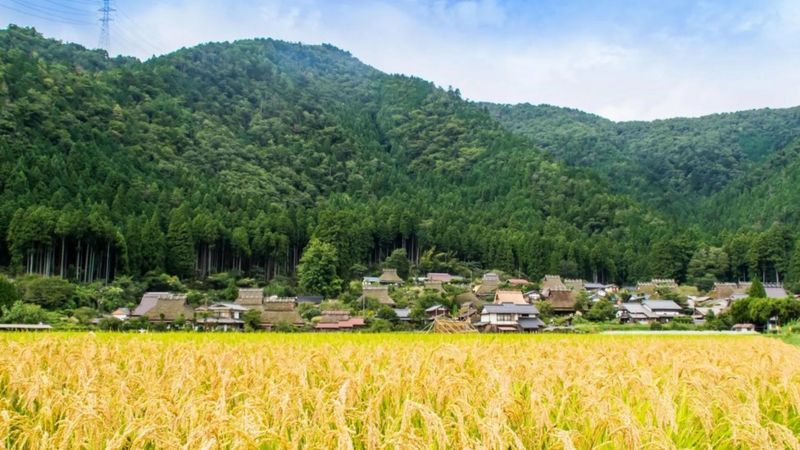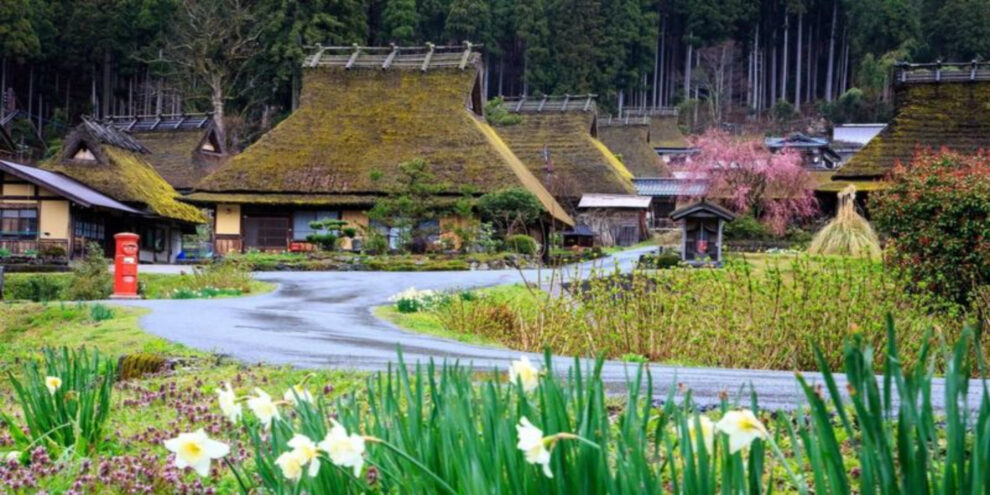The thatched-roof buildings are closely linked to Japanese history and culture, but few have survived. However, a cluster of villages near Kyoto still maintain this ancient tradition.
I arrived in Miyama in the middle of a dark winter.
When I entered the inn for the night, in a 160-year-old thatched-roof house, I was struck by its warm appearance.
The natural colors of wood fixtures and earthen floors were soothing, and I was immediately drawn to a rectangular fireplace in the center of the house, where an iron pot heated over live coals.
But it wasn’t until the next morning that I saw the roof of this very attractive house for the first time, and this is the main reason I chose to live here.
As I walked out the front door, craned my neck, I saw a patch of gray-brown thatch with patches of moss on the roof of the house. Triangular in shape and has a steep height.
The roof is so large that it seems to fill the rest of the building, and I am grateful for the rare opportunity to sleep in a structure that is now rare in rural Japan.
For at least five millennia, Japanese people have built roofs from grass, reeds, or thatch.
However, this architectural style only remains in a few clusters. Some are used as residences in the countryside, others as places of worship.
The thatched roof is actually closely related to Japan’s Shinto religion, with the imperial family as its leader.
“When the emperor ascended the throne, a thatched structure was specially made for this occasion,” explains Haruo Nishio, one of Japan’s last straw makers.
He is also the owner of the house where I stayed the night before, ‘Miyama Futon & Breakfast Honkan’. (Honkan means “main building” in Japanese).
Nishio relates that kaya, which means “thatch” in Japanese, is part of the name of the god, the mythological father of Japan’s first emperor, who was born in an unfinished hut made of woven cormorant feathers.
For Nishio, weaving is more than just a profession. It is a ritual practice that links it to its Japanese roots.
At the age of 23 in the mid-1990s, Nishio moved from Kyoto to the rural region of Miyama, 50 km away, by car into the mountains north of the city, to become a haymaker at a time when the craft was dying out.
He bought Honkan, which is registered as Tangible Cultural Property in Japan, and lived there with his family for seven years.
“Thatched roofs…created empty space, including invisible energy,” recalls Nishio.
“Maybe this is not a house, but a place of worship, and built in gratitude to God, Buddha and our ancestors.”
The Nishio family eventually moved in and made their former home available, as well as several other renovated homes in Miyama, for visitors who wished to stay.
Their business aims to “welcome travelers to experience the extraordinary lifestyle of our hometown,” said Nishio.
One night I spent in Honkan, I was not connected with any higher substance, at least I didn’t notice it.
But when I looked up at the thatched roofs, stepped onto the raised wooden floors with the hearth in the center, and saw the complete absence of any fences around the house, which Nishio said symbolized the “open-mindedness” of the people who built the grand residences, was a visionary of the builders. straw about a shelter and not a home. It resonated with me.
To be exact, Miyama means “beautiful mountains” in Japanese. This 340 square km stretch of densely forested mountains is dotted with 57 villages inhabited by 3,400 people.
Throughout most of their history, with the arduous route to Kyoto then the modern road being built 60 years ago, these settlements remained cut off from the rest of the country.
Because of this, Miyama’s early inhabitants grew up exclusively, along with their descendants, keeping rural traditions alive.
Bound to a culture of self-sufficiency, people there continue to depend on agriculture and forestry, and live in wooden thatched houses designed in a “hip-and-gable” style.
In Miyama, the roof ridge is decorated with tree trunks crossed with an odd number of X-shaped ornaments and usually indicates the social status of a family.
This model roof continues to be preserved by a community of expert haymaking, which is already 5,000 years old.
Many of the settlers here retain the “characteristics of a traditional Japanese village,” says Noriko Kamisawa, a local English-speaking guide who owns Thyme, an inn in beautifully renovated country houses.
“The landscape is the same as it was a century ago,” he added. In this respect, Miyama is a well-preserved example of satoyama, literally translated to “village” and “mountain” in Japan.
“This term is used to describe a landscape made up of a mosaic of different types of ecosystems, including secondary forests, croplands, irrigated ponds and grasslands, as well as human settlements,” explains Maiko Nishi, researcher at the United Nations University Institute for the Advanced Study of Sustainability. in Tokyo. “The core idea of satoyama is a society in harmony with nature.”
In the past, the raw material for thatch, a type of silver grass called Susuki, was cultivated and managed collectively by the Miyama community.
Currently, some Susuki must be imported from other parts of Japan; nonetheless, “it grows as long as there is sun, earth, air, and water,” says Nishio. “So by building a roof with these plants, we are telling a story of immortality.”

If wicker gave Miyama her charm, then her gem was Kayabuki no Sato, whose name means “thatched-roof village.”
The settlement is home to one of the most populous clusters of thatched roof houses in Japan, with nearly 40 buildings with thatched roofs, the oldest of which were built two centuries ago.
It was declared a national heritage site in 1993 – the government subsidized 80% of the cost of hay.
In addition, the village is also equipped with an automatic fire suppression system, in which 1,000 tons of water is stored in 62 fire huts which are tested twice every 12 months during the popular Water Hose Festival.
Thatched roofs need to be replaced every 20 years or so (old straw is recycled as fertilizer and mulch), and Kayabuki no Sato’s heritage status has helped keep Nishio’s profession alive.
As many as 15 Miyama craftsmen also work in other parts of Japan, explained Nishio, because there are so few straw craftsmen left in the country.
In general, apart from a few exceptions, thatched houses did not fare well either.
When Nishio was 26 years old, he worked as a strawman in England.
He was surprised to see that traditional houses were highly valued there, and many young artisans, there was even a weaving school.
In contrast, he says that in Japan, “a wooden house loses almost all of its value after 30 years”, and there tends to be some neglect.
It’s not only the woven straw that is threatened, Miyama himself is also threatened.
“Every year, the mostly elderly population decreases by about 100 people,” said Takamido Waka, executive director of the Kyoto Miyama Tourism Association.
As a result, in that area there is only one clinic, one elementary school and one junior high school.
“We also have two kindergartens, but next year the number will be reduced to one,” added Waka.
Nishi, a researcher, confirmed that the decline in satoyama is widespread across Japan, a country with one of the oldest populations in the world.
In this context, “sustainable tourism is one of the main strategies to revitalize these landscapes”, he says – and this is one strategy pursued by the government.
For example, the Ministry of Agriculture, Forestry, and Fisheries has created a Countryside Stays program to promote overnight stays in Miyama and other parts of Japan, which allow visitors to experience country villages, “each with its own history and traditions.” their own unique culture and way of life,” said Yoneda Taichi, who heads the program’s promotion office.
As well as increasing revenue, Miyama’s tourism influx, which is expected to see 3,000 evening visitors coming from overseas by 2022, signaling a return to pre-pandemic numbers, has helped improve services; for example, buses, to and from the nearest train station are double the frequency.
Tourism has also broken a cycle of property devaluation that Nishio says has jeopardized the viability of thatched houses.
And because the connotations of rural poverty in the past have disappeared, the people’s view of life in Satoyama has also changed, explained Waka.
“Thirty years ago, people were embarrassed to say they were from Miyama. Now, they are proud.”
Interest in local crafts, traditions and landscapes also provides impetus for their preservation.
Travelers to Miyama can experience anything from straw to organic farming to making crafts from locally harvested bamboo and visit the Little Indigo Museum, a workshop center for one of Japan’s indigo dyeing masters, and the Ashiu forest, one of the primary forests the largest in western Japan.
During my stay in Honkan, I met Toranosuke Nishio, the son of Haruo Nishio, who works in the family business.
As she feeds the chickens whose coop is at the back of the house (also with thatched roofs), we discuss why Miyama wasn’t used to being open to outsiders, for such a remote community.
Toranosuke mentions that in the past villages used to welcome travelers.
Miyama was along the ancient saba kaido, or “mackerel road,” a seafood trade route that connected Fukui prefecture to the imperial centers of Kyoto and Nara.
According to Toranosuke’s father, the villagers broaden their horizons through their interactions with travelers.
“I believe the charm of a place isn’t determined by the buildings, but by the culture and the people,” says Toranosuke, “and right now, we’re still interested in what kind of people we can meet and form relationships with.”
As the chickens pecked at the dirt floor around us, snowflakes began to fall on the Honkan’s thatched roof, glistening in the morning light.
I watched each snowflake dance through the air until it landed softly on the hay.
Perhaps this is what the gods in this house are trying to tell me: we experience the passage of time through the elements of nature, if only we pause to take in their beauty.
Source : BBC









